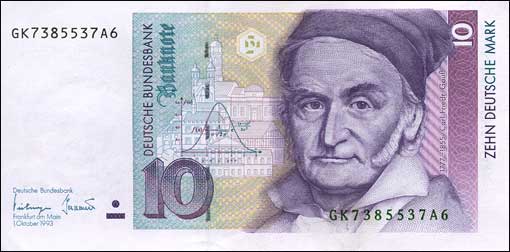|
The
Gaussian Distribution, also called the
Frequency Curve, Bell Curve, or Normal
Distribution, is one of the most widely
studied topics in all mathematics. Two
of the most common variations of the
equations are . . .
As a probability
function:

|
As
the so-called Standard Normal
Distribution:

|

The Deutsche
Mark note with Gauss' picture and
his hallmark distribution curve
has been replaced in circulation
by the Euro.
|
The strength of the Gaussian Distribution
is that it is often a very good
approximation. This assumption is
based on the Central Limit Theorem studied
in the Calculus. The "CLT" proves
that the mean of any data set, with a
distribution having both a finite mean and
finite variance, tends to be Gaussian.
This implies that test scores,
height, weight, etc., when graphed will
tend to have a "bell" shape, with very few
at either the high or low end.
|
